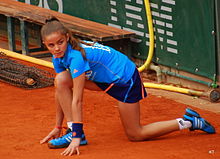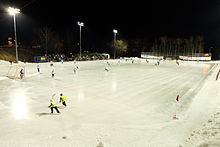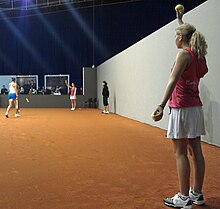Ball boy


Ball boys and ball girls[1] are individuals, usually youths, who retrieve and supply balls for players or officials in sports such as association football, American football, bandy, cricket, tennis, baseball and basketball. Though non-essential, their activities help to speed up play by reducing the amount of inactive time.
Tennis


Due to the nature of the sport, quick retrieval of loose balls and delivery of the game balls to the servers are necessary for quick play in tennis. In professional tournaments, every court will have a trained squad of ball boys/girls with positionings and movements designed for maximum efficiency, while also not interfering with active play. As well as dealing with the game balls, ball boys/girls may also provide the players with other assistance, such as the delivery of towels and drinks.[2]
Positions
- Nets are located on either side of the net to retrieve balls that are trapped by the net. Their job is to gather dead balls from the court and feed them to the bases after a point. This is usually done by rolling them alongside the court.
- Bases are located just off each corner (at either end of the baseline at either end of the court). Their job is to retrieve balls from the nets and then feed balls to the server.
Feeding
Feeding is how the ball boys and girls give the balls to the players. At different tournaments, they use different techniques for feeding. At some tournaments, bases have both arms in the air, feeding the balls with one arm; at others, they have one arm in the air which they feed the balls and the other arm behind their back. When feeding the ball, they must also be aware of a player's preference. Most players accept the standard, which is for the ball boy or girl to gently toss the ball (from the position with their arms extended upwards) such that it bounces one time then to the proper height for the player to catch the ball easily.
Hiring
There are various methods for selecting the ball boys and girls for a tournament. In many tournaments, such as Wimbledon and the Queen's Club Championships, they are picked from or apply through schools, where they are selected by tournaments and they have to go through a number of selections and tests.[2] In some other tournaments, such as the Nottingham Open, Australian Open and the US Open,[3] positions are advertised and there are open try-outs.
Applicants are required to pass a physical ability assessment. In addition to fitness and stamina, the abilities to concentrate and remain alert are essential.
Association football

High-profile association football matches may employ ball boys to avoid long delays when a game ball leaves the pitch and its immediate vicinity. Typically positioned behind advertising boards surrounding the pitch, ball boys will try to be in possession of a spare ball at all times, so that this can be given to the players prior to the loose ball being retrieved.
Methods for selecting ball boys vary between grounds.[4] On occasion, away teams have complained about perceived favour of ball boys towards home sides.[4]
Association football ball boys hit the headlines in England in a 2013 Capital One Cup match when Eden Hazard, a member of the away team, which was trailing at the time, appeared to kick at an apparently time-wasting ball boy Charlie Morgan who was lying on top of the ball.[5] Hazard was subsequently sent off for violent conduct and suspended for three games.[6] It was later revealed that the ballboy had tweeted the day before that he had intended to waste time.[7]
Baseball
Ball boys are stationed at the first and third base foul lines to retrieve out-of-play balls. Since 1992 the San Francisco Giants have employed "spry seniors" as "ball dudes", instead of the traditional youths; the following year Corinne Mullane became the first "ball dudette", and she and her daughter Molly have since been honored by the Baseball Hall of Fame as the first mother-daughter duo in major-league baseball.[8][9]
See also
References
- ^ "Ball Boys and Ball Girls". wimbledon.com.
- ^ a b About Wimbledon - Behind the scenes, Ball boys and ball girls. wimbledon.org.
- ^ Official Site Archived 2009-06-27 at the Wayback Machine United States Tennis Association - 2009 US Open Ballperson Tryouts.
- ^ a b Taylor, Louise (24 January 2013). "How football clubs choose their ballboys – and ballgirls". Guardian. Retrieved 7 June 2014.
- ^ Hytner, David (25 January 2013). "Chelsea's Eden Hazard may face longer ban for ballboy altercation". Guardian. Retrieved 7 June 2014.
- ^ "FA rules out increasing Eden Hazard's three-match ban for ballboy kick". Guardian. 31 January 2013. Retrieved 7 June 2014.
- ^ "Swansea City ballboy Charlie Morgan boasted about time wasting before Capital One semi-final with Chelsea". Telegraph. 24 January 2013. Retrieved 26 October 2018.
- ^ Jenkins, Bruce (May 10, 2020). "How first Ball Dudette landed in Hall of Fame". San Francisco Chronicle. pp. B1, B6.
- ^ Gates, Jim. "Hall of Fame 'balldude'". Baseball Hall of Fame. Retrieved June 2, 2020.

